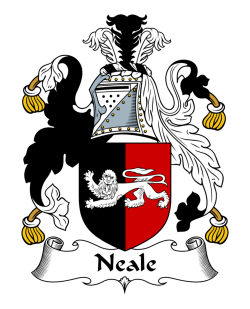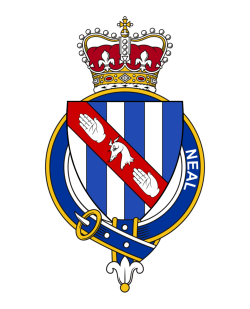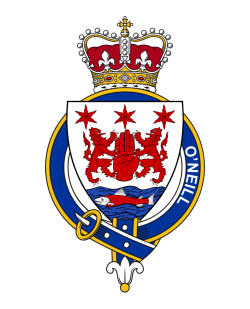
Clan MacNeil
TO CONQUER OR DIE
Clan MacNeil have historically been associated with the islands surrounding the Scottish mainland, particularly the Outer Hebridean island of Barra.
The MacNeil clan motto is"Buaidh no bas" (Victory or death) and the clan crest is a rock upon a chapeau.
Scottish History
of Clan MacNeil
Marriage and slaughter
The MacNeils can trace their origins through the O’Neil’s of Ireland to the ancient Egyptians. According to popular tradition the first Neil married an Egyptian princess who rescued Moses from the Nile and her son, Gaidhall or Gall, moved to settle in Spain, then Ireland.
Many of the Gaels who entered Ireland and eventually established a high Kingship at Tara came from the East by the way of the Iberian Peninsula. At first the Irish O’Neil’s held only the title Prince of Ulster but eventually they made the high kingship hereditary in their line. According to the legend they were crowned at Tara, on the Stone of Destiny – Jacob’s pillow when he saw the angels going up and down the ladder to heaven. This later became the Stone of Scone, used at the coronation of all the kings of Scotland and Britain since the Middle Ages, and returned to Scotland in the winter of 1996.
The legends surrounding the O’Neil’s are many. Neil of the showers called for God’s help in a famine and was given in turn a shower of gold, a shower of honey and eventually, what he had requested, a shower of wheat.
These O’Neil’s were based in Antrim when the race now known as the Scots began to cross to Argyll and the isles in the fifth century, bringing Christianity to the land to which they eventually gave their name.
It is at this point that the controversies concerning the descent of the MacNeils of Scotland begin. Clan oral tradition asserts that the son of Hugh the Solitary, an Ulster O’Neil, is said to have come to Barra in the 11th Century and to have been the founder of the MacNeils of Barra. Non Clan sources suggest the MacNeil name was formed by Gaelic families on the mainland who acquired Barra in the 14th Century.
Perhaps the truth lies in the traditional Highland saying that the MacNeils had a boat of their own at the flood. They are certainly one of the oldest Gaelic families, if not the oldest.
The Norseman invaded Scotland and made a complete conquest of the Western Isles. Some Scholars believe that all the place names in the Hebrides are of Norse origin though it seems likely that many are Gaelic names with Norse admissions.
Barra for example is probably derived from the seventh century Irish St Barr who became the patron of the MacNeils with the Norse ending ay being added at some later date to form barray, the Isle of St Barr.
The history of the isles and the MacNeils shows a continual intermingling of the Norse and Celtic cultures. And although the threat of direct Norwegian rule was broken forever at the battle of Largs in 1266 the semi-independence of the West persisted in north Celtic Lordship of the Isles.
It is generally agreed that the MacNeils acquired Barra by marriage though when this happened is matter of dispute.
Ruary MacNeil mentioned in a document of 1409 is the first named MacNeil in the ruling line.
A daughter of the last Norse leader fell in love with an illegitimate son of the MacNeils then betrayed her father. She brought her lover over to slay the Norseman and his bodyguards as they lay asleep in their great hall. Clan legend says MacNeil walked up both sides of the room decapitating the Norseman one by one. The Norse chief was the last to be killed and his head was thrown with two others into a well which is still called the well of heads.
Thus the MacNeils solved the Norse problem by the usual joint method of marriage and slaughter. Eventually the lordship of the Isles passed to the MacDonald’s with whom the MacNeils were long closely allied. In 1427 Gillian MacNeil received a charter for Barra from Alexander MacDonald of the Isles.
In the 1470’s another MacNeil fought with the Lord of the isles against his rebellious son Angus Og at the Battle of Bloody Bay, off Ardnamurchan point, though he quickly made his peace with the Crown when James the Fourth decided to suppress the Lordship in 1493.
But this MacNeil and his successors were not well disposed to meekly obeying the rule of law and order and hankered after the old Western independence. The Black Galley of the Norsemen and the Lord of the Isles now became a symbol of piracy and disruption in the eyes of the Scottish Kings.
As late as 1591 MacNeils went on full scale pirate raids against the Burkes on the West Coast of Ireland and even later, in1675, the King’s messenger attempted to serve a summons for piracy on the chief at his base, Kisimul. Stones and gunshots were fired so the messenger was in danger of being brained as he tried to a fix the writ to the castle doors. As he made his escape the chief’s younger brother sallied forth from the fortress and chased him to a neighbouring island where the writ was ripped to shreds and thrown to the four winds.
Battles and dungeons
The MacNeils had a long and stormy relationship with the monarchs of Scotland. All Scottish Clans were in the main loyal to the crown with a tradition of quarrelsome disobedience when any attempt was made to interfere with their independence. Because of their remote situation the MacNeils were more troublesome.
In the 16th Century it became the custom of the chiefs to send a herald on to the walls of Kisimul each evening after dinner to proclaim to the sea and wind.
Hear all you people and listen o ye nation – the great MacNeil of Barra having taken his meal...
A MacNeil chief and his clansmen set out to loot a Spanish galleon which had been driven ashore off Barra. As they were dismantling the ship some of the men began to wonder whether Spain might decide to take revenge for their actions.
That, responded the chief with awesome dignity, was something for the King of Spain and MacNeil of Barra to settle between themselves. The MacNeil chiefs certainly had a high and mighty opinion of themselves!
In fact the MacNeils did not regard the Kings of Scotland as a natural overlord until quite late in the day. In 1545, for example, the chief tried to arrange an alliance against the Scottish crown with Henry the eight of England and rode to London as if the Scots were foreigners. This spirit of treasonable autonomy culminated in the reign of Ruary the turbulent, chief at the time of King James VI.
His most famous exploit was the capture and looting of two ships of Queen Elizabeth the First of England returning from the Indies. The Queen sent a strong protest to King James at Edinburgh and felt obliged to take action. Roderick Mackenzie of Kintail was given the formidable task of taking the MacNeil in his lair.
Rather than use outright force he disguised himself as a Flemish merchant trading in wines and arrived at Kisimul with armed men in one hold and many casks of drink in the other.
Ruary was enticed on board by the offering of a night’s free sampling and ended up beneath the table after an astonishing display of drinking. When he woke up the next morning he found that the ship as well as his head was swaying and that Mackenzie had already begun the long journey from the north back to Edinburgh.
King James, expecting to find a savage desperado, was impressed by Ruary’s good breeding and manners. Quizzed about the looting of Elizabeth’s ship Ruary said he had done it in revenge over the execution of Mary, Queen of Scots.
So instead of being sent to the gallows Ruary was given a nominal fine and released to go home with a warning about his future conduct. Mackenzie of Kintail, for his part, was awarded the general Lordship of Barra and the surrounding isles. It appears, however that Mackenzie had occasion to chastise Ruary again at a later date and mounted a full-scale siege on Kisimul Castle. Ruary was trapped inside with only a few followers and very little provisions and sat down in desperation to try and work out some way to get rid of his enemy who were content to wait and starve them out.
Finally he remembered about a pile of sheepskins kept in one of the outhouses as winter bedding and decided to try and trick Mackenzie into believing that flock of sheep was kept inside the castle.
But how could the skins be made to look as if they were new? The castle dogs gave him the answer. They were slaughtered and their blood was smeared over the sheepskins which were then thrown over the castle wall, as if to dry.
When Mackenzie saw them he told his men the siege was futile as MacNeil obviously had enough meat to last for six months. And with that the invaders sailed away!
On another occasion Ruary had great difficulty sailing up the North Channel on his way home from a raid on the Isle of Man. When he finally reached Castle Bay, in which Kisimul island stands, he was unable to land at the fortress because night had fallen so he camped on the mainland of Barra.
Since Kisimul is only a short distance from the shore the campfire was clearly visible from the castle walls and the boatman was put in a terrible quandary. His orders were to fire on any such encampment but he knew that MacNeil was expected back at any moment and might have been driven ashore by the stormy conditions. He decided to solve the problem by loading the castle cannon with the insides of a bullock so that he could always say he had fired on the camp. The shot was deadly accurate landing on the campfire and the MacNeils found themselves supplied with a delicious and already cooked meat supper.
Ruary had two sons – one was born legitimately by a daughter of the Duart MacLean’s, the other out of wedlock by the sister of MacDonald of Clanranald. Inevitably the two sons fought each other for the succession even before their father’s death.
Ruary himself favoured the Macdonald line and the legitimate heirs were packed off to Mull to plot with their MacLean In-laws. Eventually the MacLean sons decided to recover their rights by storming Kisimul, which they did successfully.
Ruary died in the castle dungeons, still a prisoner of his MacLean sons, and was forced to give them the succession, the MacDonald claimants being bought off with land in South Uist.
Feuds of this sort were common throughout the highlands in the 16th Century and, in the West, continued with vigour until the 1745 rebellion as no new MacNeil chief was accepted by the clan until he had made at least one raid on his neighbours. As one quarrel blew over another sprang up. Generally the MacNeils veered between their old allies the MacDonald’s and the MacLean’s of Duart who, like the Campbell’s, had risen in influence on the fall of the Lordship of the Isles.
In 1585, for the only time in history, the MacNeils were split in battle when the mainland MacNeils fought with the Macdonald against their Barra cousins who turned out for the MacLean’s. The MacLean side won, killing 340 of the enemy, and in the process incurred the wrath of the King. James the sixth then issued a series of writs against the Western Clans and successfully contained their quarrels, though it was almost impossible to enforce the law effectively on an island as remote as Barra.
In 1601 there was another fight with the Macdonalds which resulted in the MacNeils losing most of their South Uist possessions. Then Neil of MacNeil, a son of Ruary Tartar, fought with almost all the surrounding clans during his chieftainship.
The MacNeils supported the Stewart line during the Jacobite uprisings. Their first appearance in the royal cause was as part of the army which tried to restore Charles the second after his father’s execution, and which was routed at the battle of Worcester in 1651.
In 1688 the MacNeil chief received a new charter for his Barra lands from James the seventh and repaid the debt by fighting in Bonnie Dundee’s army at Killiecrankie. It was here that he was seen panting and groaning under the weight of a huge battleaxe in a furious downhill charge which scattered the army. The MacNeils also fought at Sheriffmuir in 1715 and the Chief’s sons were forced to go into exile when the Stewart cause went down again.
The Clan’s contribution to the ’45 was less glorious but even more costly. Bonnie Prince Charlie made his first landing on Scottish soil in MacNeil territory at Esriskay. Roderick the Dove, Chief of MacNeil, was no great warrior as his name suggests and preferred to contribute to the cause by sending secret supplies of men and money to join the Prince’s army as it marched south.
After the uprising ended in the fiasco at Culloden Roderick was arrested and taken to London along with Flora Macdonald, Lord Lovat and many others, where he was kept prisoner for three years. Roderick had been accused of giving one of Prince’s lieutenant’s gold from a Spanish galleon which had come into Mac Neil’s possession.
Family History Mini Book
We hope you enjoyed reading this excerpt from this mini book on the Scottish history of the MacNeil family.
You can buy the full book for only120 Clan MacNeil
Tartan Products
The Crests
of Clan MacNeil























































































